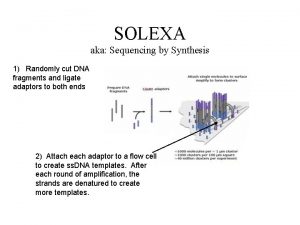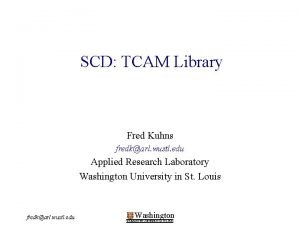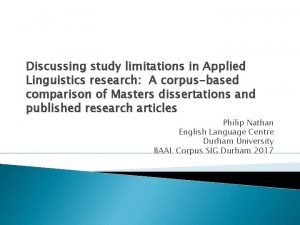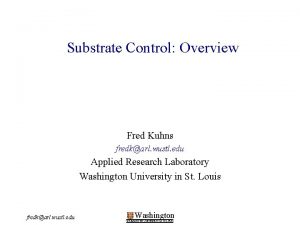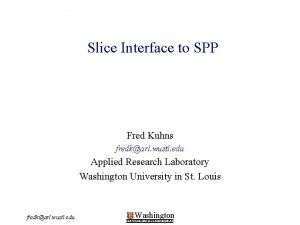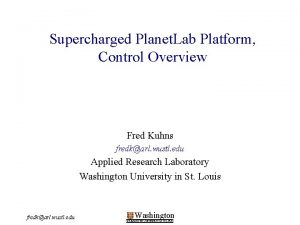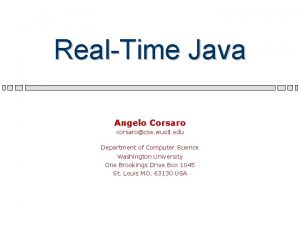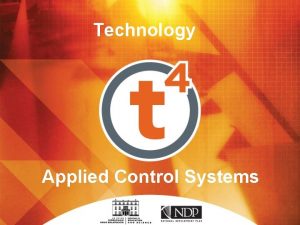Control Fred Kuhns fredkarl wustl edu Applied Research























- Slides: 23

Control Fred Kuhns fredk@arl. wustl. edu Applied Research laboratory Department of Computer Science and Engineering Washington University in St. Louis fredk@arl. wustl. edu Washington WASHINGTON UNIVERSITY IN ST LOUIS

Virtual Networking – Basic Concepts Substrate Links interconnect adjacent Substrate Routers One or more Meta Router instances Substrate Router Meta Links interconnect adjacent Meta Routers. Defined within substrate link context Fred Kuhns - 9/17/2020 substrate links may be Tunneled within existing networks: IP, MPLS, etc. Washington WASHINGTON UNIVERSITY IN ST LOUIS 2

Adding a Node Install new substrate router Define meta-links between meta nodes (routers or hosts) Create substrate links between peers Instantiate meta router(s) Fred Kuhns - 9/17/2020 Washington WASHINGTON UNIVERSITY IN ST LOUIS 3

System Components • General purpose processing engines (PE/GP). – Shared: Planet. Lab VM environment. • Local Planetlab node manager to configure and manager VMs – vserver, vnet may change to support substrate functions • Implement substrate functions in kernel – rate control, mux/demux, substrate header processing – Dedicated: no local substrate functions • May choose to implement substrate header processing and rate control. • Substrate uses VLANs to ensure isolation (VLAN == MRid) • Can use 802. 1 Q priorities to isolate traffic further. • NP blades (PE/NP). – Shared: user supplies parse and header formatting code. – Dedicated: User has full access to and control over the hardware device • General Meta-Processing Engine (MPE) notes: – Use loopback to enforce rate limits between dedicated MPEs – Legacy node modeled as dedicated MPE, use loopback blade to remove/add substrate headers. • Substrate links: Interconnect substrate nodes – Meta-links defined within their context. – Assume an external entity configures end-to-end meta-nets and meta-links – Substrate links configured outside of the node manager’s context Fred Kuhns - 9/17/2020 Washington WASHINGTON UNIVERSITY IN ST LOUIS 4

Switch • Switch Blade Specs: – Promentum™ ATCA-2210 – http: //www. radisys. com/products/ds-page. cfm? productdatasheetsid=1191 – 20 -port 10 GE fabric switch • 14 10 GE links to user slots • 4 10 GE links for external connections (up/cross links) on front panel – 24 -port 1 GE Base switch • 14 1 GE links to users lots • 1 GE link to redundant switch blade • 1 10 GE and 4 1 GE links for external connections (up/cross links) on front panel – Wire-speed L 2 and L 3 switching – 4 K IEEE 802. 1 Q VLANs – Etc… • Traversing the Switch: – Switching is based on Ethernet Destination Address – Isolation is based on VLAN. • One VLAN will be assigned to each Meta. Net present on a Substrate Router. • All switch traffic for a Meta. Net will be required to use its assigned VLAN. – Frames from a Meta. Net will only be transmitted to a port which is allowed to receive the specified VLAN. Fred Kuhns - 9/17/2020 Washington WASHINGTON UNIVERSITY IN ST LOUIS 5

Packet Processing • Key features – 16 32 bit 1. 4 GHz Micro-engines • • peak instruction rate >20 GIPs 8 hw contexts per processor support >50 i/byte (input & output) pipeline connections for streaming – four QDR SRAM interfaces and three RDRAM interfaces – high IO bandwidth (up to 20 G) – Xscale control processor – encryption/decryption engine Fred Kuhns - 9/17/2020 Washington WASHINGTON UNIVERSITY IN ST LOUIS 6

System Architecture • no change to current apps – also support dedicated blades – use separate blade server to preserve ATCA slots for NPs . . . PE/NP – shared blades run Plab OS PE/GP compute blade with disk Radisys 7010 . . . 10 GE Switch Blade Line Card • General purpose blades. Radisys 7010 with RTM up to 10 1 GE interfaces 1 GE for control 10 Gb/s for data • NP blades. – support dedicated PEs • control from Vserver on PE/GP – shared PE options • shared NP for fast path • Fred shared NP with plugins Kuhns - 9/17/2020 Washington WASHINGTON UNIVERSITY IN ST LOUIS 7

Block Diagram of a Meta-Router Control/Management using Base channel (Control Net: IPv 4) Meta Interfaces (MI): MI connected to meta-links 1 G 1 G 0 1 . 5 G 2 MPEk 1 2 G 1 G 3 4 . 5 G 5 MPEk 2 MPEk 3 data path 3 G . 1 G Meta Switch 3 G control. 1 G MPEs interconnected in data plane by a meta-switch. Packet includes Meta-Router and Meta-PE identifier Meta-Router Some Substrate detected errors or events reported to Meta-Router “control” MPE. Meta-Processing Engines (MPE): - virtual machine, COTS PC, NPU, FPGA - PEs differ in ease of “programming” and performance - MR may use one or more PEs, with possibly different types The first Meta-Processing Engine (MPE) assigned to Meta-Network MNetk called MPEk 1 Fred Kuhns - 9/17/2020 Washington WASHINGTON UNIVERSITY IN ST LOUIS 8

System Block Diagram RTM NPU-B TCAM 2 x 1 GE NPU-A xscale … GP CPU PE/GP LC LC xscale … Gb. E interface X NPU-B PCI PE/GP NPU-A PE/NP 2 x 1 GE PE/NP RTM 10 x 1 Gb. E … X Fabric Ethernet Switch (10 Gbps, data path) Base Ethernet Switch (1 Gbps, control) Node Server Node Manager Loopback map VLANX to VLANY I 2 C (IPMI) user login accounts Shelf manager Fred Kuhns - 9/17/2020 Washington WASHINGTON UNIVERSITY IN ST LOUIS 9

Top-Level View (exported) of the Node PE/NP … (control, IPaddr) (platform, IXP 2800) PE/NP (type, IXP_SHARED) (control, IPaddr) … (platform, IXP 2800) (type, IXP_DEDICATED) … … PE/GP (control, IPaddr) (platform, PE/GP x 86) (type, linux_vserver) (control, IPaddr) … (platform, x 86) (type, dedicated) … S-Link … (type, p 2 p) (peer, _Desc_) S-Link (BW, XGbps) (type, p 2 p) …(peer, XXX) (BW, XXGbps) … Exported Node Resource List (Processing engines, Substrate Links) Node Server Substrate Control user login accounts Node Manager Fred Kuhns - 9/17/2020 Washington WASHINGTON UNIVERSITY IN ST LOUIS 10

Substrate: Enabling an MR Allocate control-plane MPE Meta-Router MR 1 for MNetk (required) Update host with local Net gateway MNetk Data Plane Host MPEk 1 (located within node) MPEk 2 PE MNetk MI 4 loopback 2 4 5 MI 0 LC Enable VLANk on fabric switch ports 0 Enable control over Base switch (IP-based) VLANk 10 Gb. E (fabric) Use loopback to define interfaces internal to the system node. Fred Kuhns - 9/17/2020 PE 1 MNetk Update shared MPEs LC for. Substrate MI and inter. MPE traffic MPEk 3 PE 3 local Allocate data-plane MPEs MNetk Control and Management Plane 6 7 MNetk MI 1 MI 2 … MI 3 Line card Define Meta-Interface mappings Washington WASHINGTON UNIVERSITY IN ST LOUIS 11

Block Diagram Line Card map received packet to MR and MI Each MR: MI pair is assigned its own rate controlled queue Lookup table Shared PE map to Port, Meta Link pair … … map to MR: MI MR 1 Shared PE/NP 2 Meta-Interfaces are rate controlled ‘slice’/MN VMs? Fred Kuhns - 9/17/2020 Base switch (control) Node M. 1 map to Port Meta Link pair 2 Shared PE/GP VMM? Internet Node Server MR 5 Lookup table … 1 … … MR 4 Line Card … … map to MR: MI Fabric Switch Lookup table MR 3 … … Line Card Dedicated PE Fabric Switch … MR 2 MR 5: MI 1 Line Card “VM” manager meta-router meta-net 5 control App-level service Washington WASHINGTON UNIVERSITY IN ST LOUIS Meta-net control and management functions (configure, stats, routing etc). Communicate with MR over separate base switch. 12

Partitioning the Control plane • Substrate manager – Initialization: discover system HW components and capabilities (blades, links etc) – Hides low level implementation details – Interacts with shelf manager for resetting boards or detecting failures. • Node manager – Initialization: request system resource list – Operational: Allocate resources to meta-Networks (slice authorities? ) – Request substrate to reset MPEs • Substrate assumptions: – All MNets (slices) with a locally defined meta-router/service (sliver) have a control process to which it can send exception packets and event notifications. • Communication: – out-of-band uses Base interface and internal IP addresses – in-band uses data plane and MPE id. • Notifications: – ARP errors, Improperly formatted frame, Interface down/up, etc. – If meta-link is a pass-through link then the Node manager is responsible for handling meta-net level errors/event notification. For example link goes down. Washington Fred Kuhns - 9/17/2020 13 WASHINGTON UNIVERSITY IN ST LOUIS

Initialization: Substrate Resource Discovery • Creates list of devices and their Ethernet Addresses – Network Processor (NP) blades: • Type: network-processor, Arch: ixp 2800, Memory: 768 MB (DRAM), Disk: 0, Rate: 5 Gbps – General Processor (GP) blades: • Type: linux-vserver, Arch: X, Memory: X, Disk: X, Rate: X – Line Card blades: • not exposed to node manager, used to implement meta-interfaces • another entity creates substrate links to interconnect peer substrate nodes. • create table mapping line card blades, physical links and Ethernet addresses. • Internal representation: – Substrate device ID: <ID, SDid> – If device has a local control daemon: <Control, IP Address> – Type = Processing Engine (NP/GP): • <Platform, (Dual IXP 2800|Xeon|? ? ? )>, <Memory, #>, <Storage, #> <Clock, (1. 4 GHz|? ? ? )> <Fabric, 10 Gb. E>, <Base, 1 Gb. E>, ? ? ? – Type = Line Card • <Platform, Dual IXP 2800> <Ports, {<Media, Ethernet>, <Rate, 1 Gbps>}>, ? ? ? – Substrate Links • <Type, p 2 p>, <Peer, Ethernet Address>, <Rate Limit>, … • Met-Link list <MLid, MLI>, <MR, MRid>, … Fred Kuhns - 9/17/2020 Washington WASHINGTON UNIVERSITY IN ST LOUIS 14

Initialization: Exported Resource Model • List of available elements – Attributes of interest? • Platform: IXP 2800, Power. PC, ARM, x 86; Memory: DRAM/SRAM; Disk: XGB; Bandwidth: 5 Gbps; VM_Type: linux-vserver, IXP_Shared, IXP_Dedicated, G__Dedicated; Special: TCAM – network-processor: NP-Shared, NP-Dedicated – General purpose: GP-Shared (linux-vserver), GP-Dedicated – Each element is assigned an IP address for control (internal control LAN) • List of available substrate links: – Access networks (expect Ethernet LAN interface): substrate link is multiaccess • Attributes: Access: multi-access, Available Bandwidth, Legacy protocol(s) (i. e. IP), Link protocol (i. e. Ethernet), Substrate ARP implementation. – Core interface: assume point-to-point, Bandwidth controlled • Attributes: Access: Substrate; Bandwidth, Legacy protocol? Fred Kuhns - 9/17/2020 Washington WASHINGTON UNIVERSITY IN ST LOUIS 15

Instantiate a router: Register MNet • Substrate assumptions: – All MNets (slices) with a locally defined meta-router/service (sliver) will have defined a control process to which it can send exception packets and event notifications. • Communication: out-of-band uses Base interface and internal IP addresses, in band uses data plane. ? ? ? • Notifications: ARP errors, Improperly formatted frame, Interface down/up, etc. – If meta-link is a pass-through link then the Node manager is responsible for handling errors/event notification. • Node manager Actions: – Request binding of MNidk to allocated device (use SDid from initialization) • Substrate enables VLANk on applicable ports of the fabric switch – Allocate hardware resources (see following discussion for different scenarios) – If control module already instantiated then notify it of the MR location (IP address of control interface). – If creating control entity then register it with any line cards with meta-router interfaces (for exception traffic). ? ? ? Fred Kuhns - 9/17/2020 Washington WASHINGTON UNIVERSITY IN ST LOUIS 16

Instantiate a router: Register Meta-Router (MR) • Define MR specific Meta-Processing Engines (MPE): – Register MR ID MRidk with substrate • substrate allocates VLANk and binds to MRidk, – Request Meta-Processing Engines • shared or dedicated, NP or GP, if shared then relative allocation (rspec) – shared: implies internal implementation has support for substrate functions – dedicated w/substrate: user implements substrate functions. – dedicated no/substrate: implies substrate will remove any substrate headers from data packets before delivering to MPE. For legacy systems. • indicate of this MPE is to receive control events from substrate (Control_MPE). • substrate returns MPE id (MPid) and control IP (MPip) address for each allocated MPE • substrate internally records Ethernet address of MPE and enables VLAN on applicable port • substrate assumes that any MPE may send data traffic to any other MPE – MPE specifies target MPE rather then MI when sending packet. Fred Kuhns - 9/17/2020 Washington WASHINGTON UNIVERSITY IN ST LOUIS 17

Instantiate a router: Register Meta-Router (MR) • Create meta-interfaces (with BW constraints) – create meta-interfaces associated with external substrate links • request meta-interface id (MIid) be bound to substrate link x (SLx). – we need to work out the details of how a SL is specified • We need to work out the details of who assigns inbound versus outbound meta-link identifiers (when they are used). If downstream node then the some entity (node manager? ) reports the outgoing label. This node assigns the inbound label. • multi-access substrate/meta link: node manager or meta-router control entity must configure meta-interface for ARP. Set local meta-address and send destination address with output data packet. • substrate updates tables to bind MI to “receiving” MPE (i. e. were substrate sends received packets) – create meta-interfaces for delivery to internal devices (for example, legacy Planetlab nodes) • create meta-interface associated with an MPE (i. e. the endsystem) Fred Kuhns - 9/17/2020 Washington WASHINGTON UNIVERSITY IN ST LOUIS 18

Line Cards: Assumptions • Initially use a simplified model – Core interfaces has point-to-point substrate links which correspond (physically or logically) to physical links. – LAN interfaces only support legacy IP traffic Fred Kuhns - 9/17/2020 Washington WASHINGTON UNIVERSITY IN ST LOUIS 19

Scenarios • Shared PE/NP, send request to device controller on the XScale – Allocate memory for MR Control Block – Allocate microengine and load MR code for Parser and Header Formatter – Allocate meta-interfaces (output queues) and assign Bandwidth constraints • Dedicated PE/NP – Notify device control daemon that it will be a dedicated device. May require loading/booting a different image? • Shared GP – use existing/new Planet. Lab framework • Dedicated GP – legacy planetlab node – other Fred Kuhns - 9/17/2020 Washington WASHINGTON UNIVERSITY IN ST LOUIS 20

IPv 4 • Create the default IPv 4 Meta-Router, initially in the non-forwarding state. – Register Meta. Net: output Meta-Net ID = MNid – Instantiate IPv 4 router: output Meta-Router ID = MRid • Add interfaces for legacy IPv 4 traffic: – Substrate supports defining a default protocol handler (Meta -Router) for non-substrate traffic. – for protocol=IPv 4, send to IPv 4 meta-router (specify the corresponding MPE). Fred Kuhns - 9/17/2020 Washington WASHINGTON UNIVERSITY IN ST LOUIS 21

General Control/Management • Meta routers use Base channel to send requests to control entity on associated MPE devices • Node manager sends requests to central substrate manager (xml-rpc? ) – request to both configure, start/stop and tear down meta-routers (MPEs and MIs). • Substrate enforces isolation and policies/monitors meta-router sending rates. – Rate exceeded error: If MPE violates rate limits then its interface is disabled and the control MPE is notified (over Base channel). . • Shared NP – xscale daemon – requests: start/stop forwarding; Allocate shared memory for table; Get/set statistic counters; Set/alter MR control lock; Add/Remove lookup table entries. – Lookup entries can be added to send data packets to control MPE, packet header may contain tag to indicate reason packet was sent – mechanism for allocating space for MR specific code segments. • dedicated NP – MPE controls XScale. When XScale boots a control daemon si told to load a specific image containing user code. Fred Kuhns - 9/17/2020 Washington WASHINGTON UNIVERSITY IN ST LOUIS 22

ARP for Access Networks • The substrate offers an ARP service to meta-routers • Meta-router responsibilities: – before enabling interface must register its meta-network address associated with meta-interface – send destination (next-hop) meta-net address with packets (part of substrate internal header). Substrate will use arp with this value. – if meta-router wants to use multicast or broadcast address then it mus also supply the Link layer destination address. So the substrate must also export the Link layer type. • substrate responsibilities – all substrate nodes on an access network must agree on meta-net identifiers (MLIs) – Issues ARP requests/responses using supplied meta-net addresses and met-net id (MLI). – maintain ARP table and timeout entries according to relevant rfcs. – ARP Failed error: If ARP fails for a supplied address then substrate must send packet (or packet context) to control MPE of meta-router. Fred Kuhns - 9/17/2020 Washington WASHINGTON UNIVERSITY IN ST LOUIS 23
 Applied research means
Applied research means Contrast applied research and basic research
Contrast applied research and basic research Example of applied research
Example of applied research Bryman bell
Bryman bell Papercut wustl
Papercut wustl Wusm room reservation
Wusm room reservation Rsvp center washu
Rsvp center washu Wugo wustl
Wugo wustl Wustl travel policy
Wustl travel policy Green office management
Green office management Ccir wustl
Ccir wustl Wustl library databases
Wustl library databases Wugo news
Wugo news Edu.sharif.edu
Edu.sharif.edu Research comes from the word
Research comes from the word Applied vs fundamental research
Applied vs fundamental research Empirical research meaning
Empirical research meaning Basic and applied research
Basic and applied research Research findings example
Research findings example Marketing research nature
Marketing research nature Midterm exam for applied research methods
Midterm exam for applied research methods Elena motoiu
Elena motoiu What are the limitations of applied linguistics
What are the limitations of applied linguistics Research methodology in applied economics
Research methodology in applied economics




